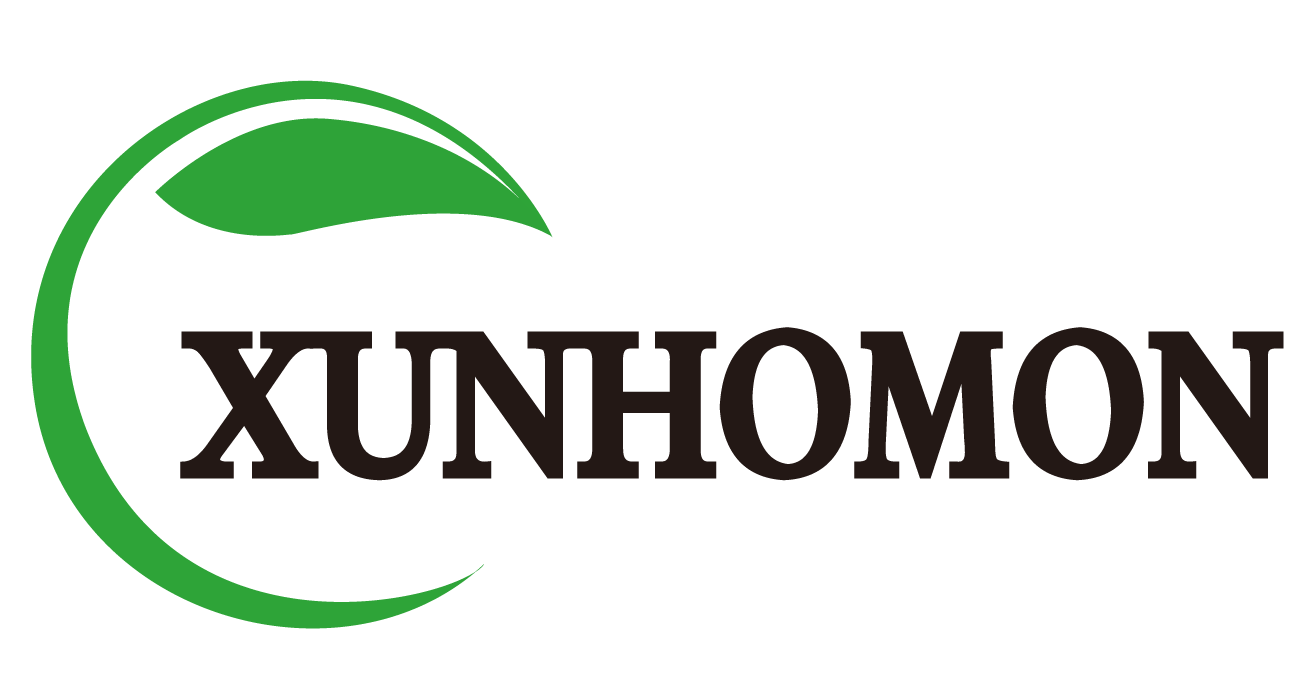What is Qi2 ?
1. Introduction
In recent years, wireless fast charging technology has developed rapidly, and more and more mobile phones and digital devices have begun to support wireless fast charging. For ordinary consumers, this technology allows charging to be bound by the wire, making the charging scene simple and safe. Greatly improve the user experience of charging. Therefore, it is not surprising that wireless fast charging technology is favored, but like wired charging technology, wireless fast charging technology, although it looks more cool and more technological, has its own charging specifications.
Wireless fast charging specifications, there are many kinds of specifications, one of which is the organization called WPC developed, this specification must be you have heard, it is the Qi (fourth sound) protocol. Here is the charging head network with you to uncover Qi is not very mysterious veil.
2. Know Qi
To understand the wireless fast charge protocol Qi, we need to first understand the organization that developed Qi – WPC.
WPC full name Wireless Power Consortium, Chinese name “wireless charging Alliance”, was founded on December 17, 2008, is the world’s first standardization organization to promote wireless charging technology. As of May 2023, there are 315 WPC members working together with a common goal: to achieve full compatibility of all wireless chargers and wireless power supplies worldwide. For this reason, they have developed many specifications for wireless fast charging technology.
2.1 Set Standards
As wireless charging technology continues to evolve, its application scope has expanded from consumer handheld devices to many new areas, such as laptops, tablets, drones, robots, car networking, and smart wireless kitchens. WPC develops and maintains a range of standards for a wide variety of wireless charging applications, including:
1) The Qi standard: is for smartphones and other portable mobile devices.
2) Ki Wireless kitchen standard: for kitchen appliances that can support up to 2200W of charging power.
3) The Light Electric Vehicle (LEV) standard: makes wireless charging of light electric vehicles such as electric bicycles and scooters faster, safer, smarter and easier at home and on the go.
4) Industrial wireless charging standard: for safe and convenient wireless power transmission to charge robots, AGVs, drones and other industrial automation machinery.
There are now more than 9,000 QI-certified wireless charging products on the market. WPC verifies the safety, interoperability and suitability of products through its independent, authorized testing laboratories around the world.
2.2 Membership type
WPC divides members into four types according to the annual membership fee paid by members, and different types enjoy different services and rights. The following are the details of members:
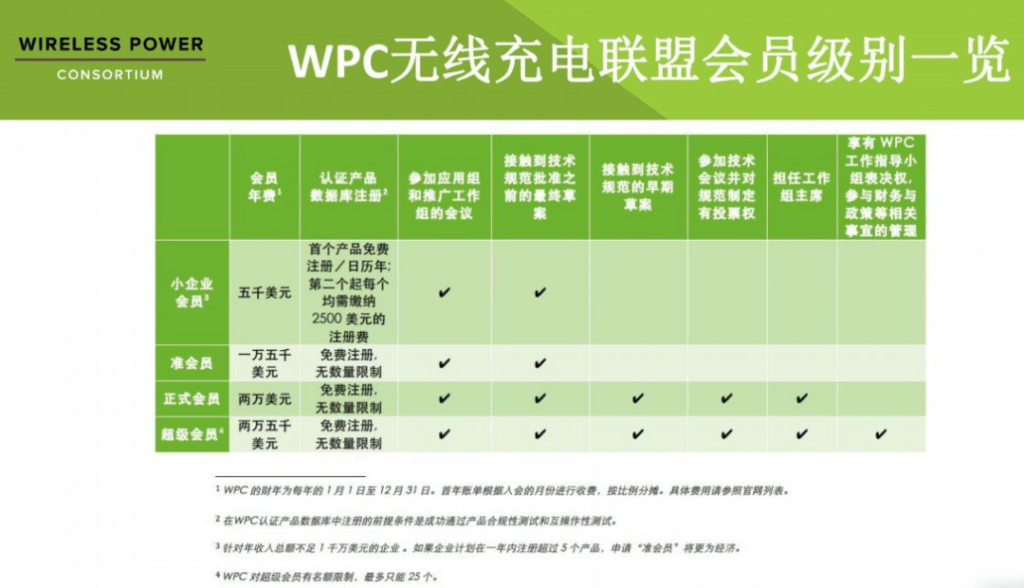
1) Small business member (Small business member) : for companies with annual revenue of less than $10 million, only pay an annual fee of $5,000, but each product registered in the product library needs to pay a fee of $2,500, and the first product can be registered for free.
2) Associate Member (Associate Member) : pay an annual fee of 15,000 US dollars, can obtain the Qi trademark license, can participate in the Qi product interoperability test, through the evaluation of the draft specification to influence the draft formulation, free of charge in the product registration database, and there is no limit on the number of products, but has no right to participate in technical meetings.
3) Full Member (Full Member) : pay an annual fee of $20,000, can participate in all working group and special task force meetings, can subscribe to all mail, free product registration database registration products, and no number limit.
4) Super Member (Regular Member) : pay an annual fee of $25,000, can organize events and attend meetings, can serve as the chair of the working group, have the right to vote in the WPC work steering group, register products in the product registration database free of charge, and there is no limit on the number of products.)
2.3 Number of members
As of July 5, 2023, a total of 328 companies around the world have become members of the WPC Wireless Charging Alliance, involving 23 countries and regions around the world.
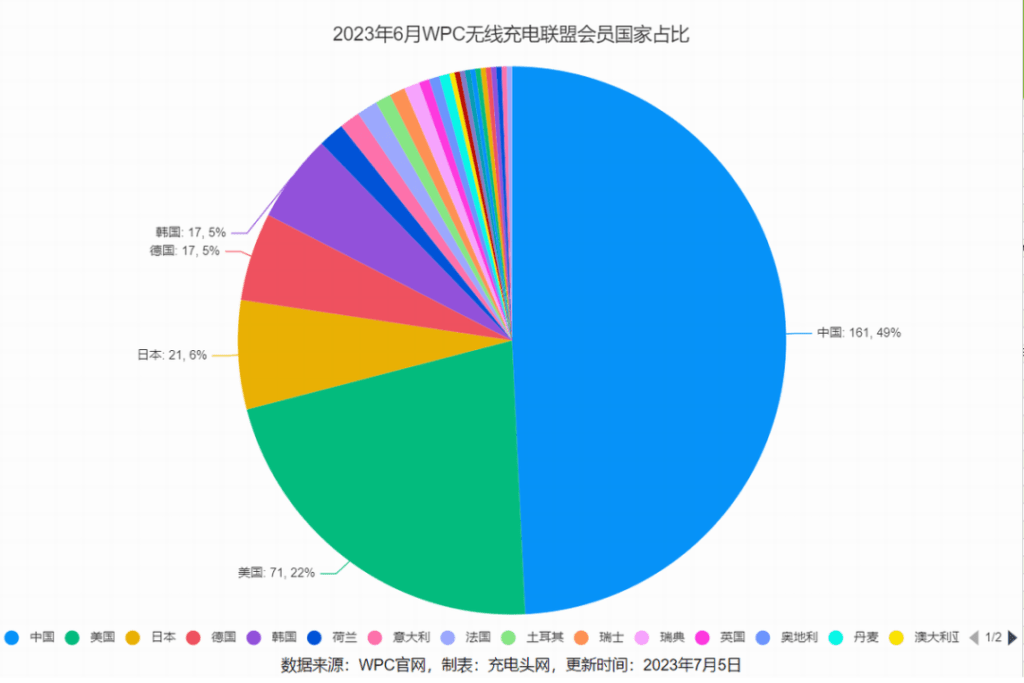
The pie chart shows that members of the WPC wireless charging Alliance from China account for 49%, nearly half; WPC wireless charging alliance member companies from the United States accounted for the second, reaching 22%; Japan WPC wireless charging alliance member enterprises accounted for 6%, Germany and South Korea WPC wireless charging alliance member enterprises accounted for 5% each; WPC Wireless charging alliance member companies in other countries and regions accounted for 13%. The overall proportion is the same as that in May.
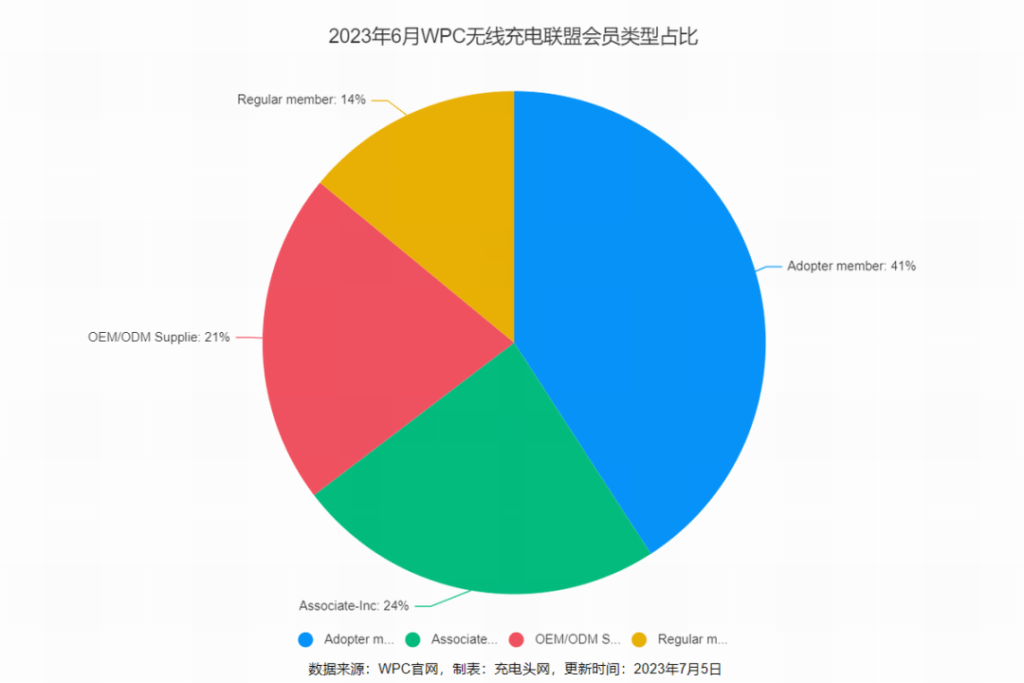
The pie chart of WPC Wireless charging Alliance membership level shows that Adopter member (ordinary member) accounts for the highest proportion, reaching 41%; Associate-Inc (Associate members) accounted for the second place, reaching 24%, an increase of 1% compared to the previous month; Regular member (full member) accounts for the third, reaching 21%; OEM/ODM Supplier (OEM/ODM supplier members) followed with 14%, down 1% from the previous month.
3. Qi Introduction
Qi protocol as a WPC for smart phones and other portable mobile devices technology, is currently one of the mainstream wireless fast charging technology, the reason is “one” because there are other fast charging protocols, we follow a special column to explain. The existing Qi protocols include Qi 1.2.4 and Qi 1.3.3. What is worth bringing together is the upcoming release of Qi 2.0.
Qi is an open universal standard that can be used with any Qi device, so consumers do not need to use separate chargers, cables and adapters, and can safely and easily conduct wireless charging in various places such as homes, offices, stations, and hotels. Products using Qi technology must undergo rigorous testing to ensure safety, interoperability and energy efficiency. Only products that pass these independent laboratory tests can use the Qi mark and are considered Qi certified. The Qi 1.3.3 protocol, which is currently being widely used, supports a maximum charging power of 15W.
3.1 History of Qi development
Charging protocols will always iterate and update in the development of technology, as the wireless charging standard Qi protocol is the same, since the release of Qi 1.0 in October 2010, to now 2023, the upcoming release of Qi 2.0. Qi protocol has been released Qi 1.2.4, Qi 1.3.3 released three generations.
3.2 Qi Certification Process
Qi is the world’s first Wireless charging alliance (Wireless Power Consortium, referred to as WPC) launched the wireless charging standard, with convenience and versatility two characteristics. Qi is a universal standard, and products using Qi technology must be rigorously tested to ensure safety, interoperability and energy efficiency. Only certified products can use the Qi logo. Different brands of products, as long as there is a Qi logo, can achieve Qi wireless charging. At present, the certification content of Qi certification is very clear, and the following is the certification process of Qi protocol.
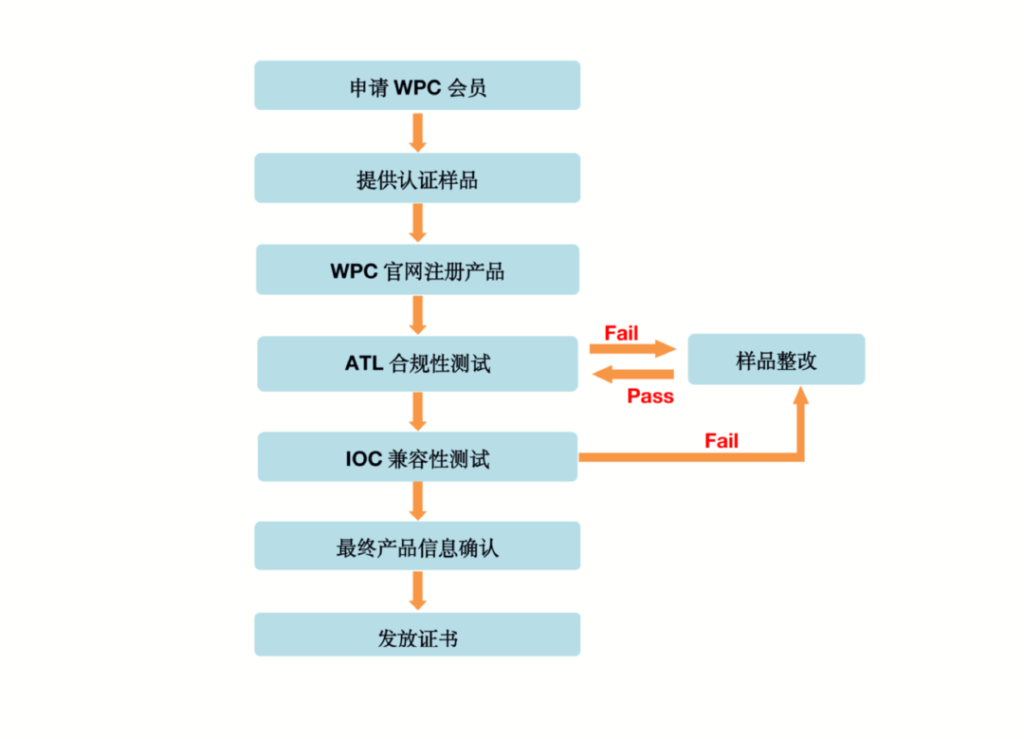
The current certification range of the Qi protocol is V 1.2.4 BPP EPP PPDE and V 1.3.3 BPP EPP PPDE. I believe that everyone is very confused about the concept of BPP and EPP, in fact, BPP, EPP refers to the type of coil, because the key component of wireless charging is the electromagnetic coil, relying on the electromagnetic coil to do magnetic and electrical conversion. The specific technical principle is not discussed here, we understand that BPP and EPP are coil types under different technical specifications of the Qi protocol. Several common coil types are as follows:
1) Single coil: A11, A11a, MP-A2
2) Multiple coils: A28, MP-A
So, what is the content of Qi-BPP certification and Qi-EPP certification, and what is the difference?
1) Qi-BPP certification
First of all, the Qi protocol stipulates that the product supports less than 5W power, and the use of BPP coils must be BPP certified. The common BPP coils have the A11 and A28 mentioned above, so the wireless charging products using such coils need to do Qi-BPP certification.
2) Qi-EPP authentication
The same as Qi-BPP certification, the product supports more than 5W power, the use of EPP coils (such as: MP-A2, MP-A9), must be EPP certification.
3.3 Qi -- Number of product certifications
We have counted the number of Qi products that have passed certification in a single month since the first six months of 2023. Among them, the largest number of certified products reached 100 in June. The following are the details:

Looking back at the past, the number of passes showed an increasing trend from January to June, decreased in April, continued to rise in May, and reached the highest peak in June.
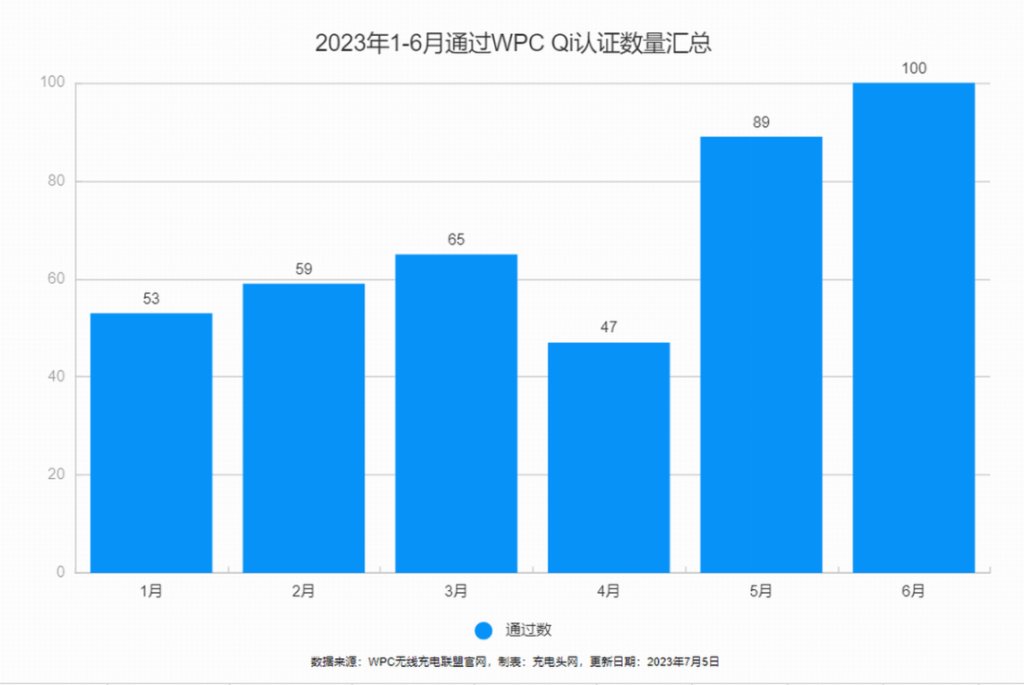
Looking back at the past, the number of passes showed an increasing trend from January to June, decreased in April, continued to rise in May, and reached the highest peak in June.
4. Qi 2
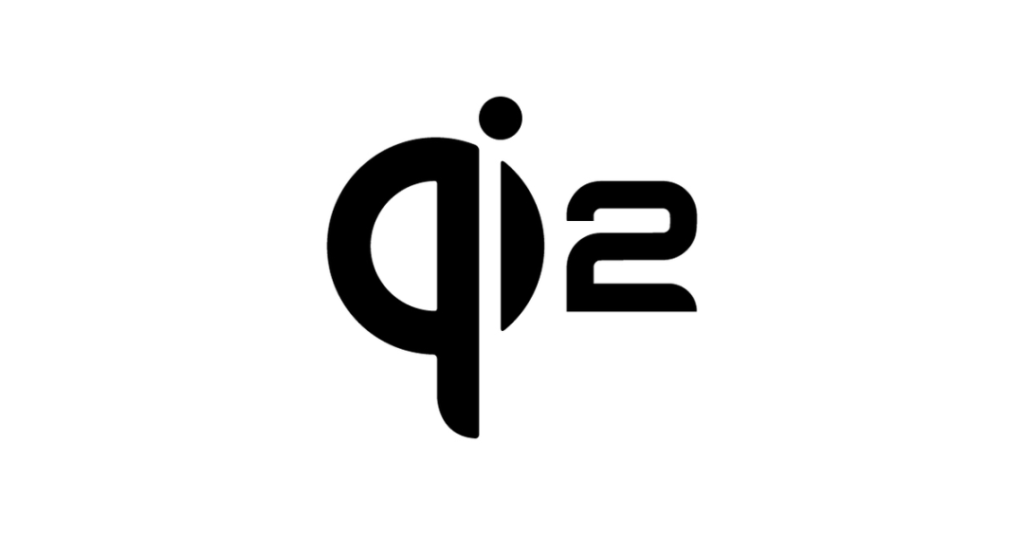
After the Qi2 upgrade, it uses the new Qi Logo. The most important is to join the MPP (Magnetic Power Profile Magnetic Power Segment) protocol, which includes MPP as a technology branch under Qi2. In addition, all certification specifications must integrate authentication. For manufacturers, the “transmit coil reference type” is no longer required. Prior to this, WPC had a library of reference coils, which manufacturers needed to select. Not only that, there is no need to report the PTx coil reference type during the certification process, giving manufacturers a great degree of convenience and increasing the freedom of product design.
4.1 Qi2 Technology update
Currently, the technologies covered by Qi2 (PTx) include two technologies, EPP and MPP, and no longer include BPP alone. EPP and MPP both need to carry out identity authentication, the same as the original intention of Qi1.3.3, WPC wants to further promote the popularity of fast charge terminal rate, but Qi1.3.3 did not complete this mission, so now the mission is passed to the Qi2.0 protocol. In order to further popularize medium and high power charging, Qi2.0 no longer contains a separate BPP charging protocol, but can be backward compatible with the BPP protocol.
As just mentioned, Qi2’s technical update is mainly to join the MPP protocol, and we have previously given everyone the popular science Qi-BPP certification and Qi-EPP certification. So what is Qi-MPP certification?
4.2 Qi2 Authentication
In the Qi 2.0 certification process, all certified products must have an authentication chip (product unit certificate), and the authentication chip certification is completed with the assistance of the WPC designated MCSP (Manufacturer CA service provider). The following is a list of MCSPS and the main authentication process.
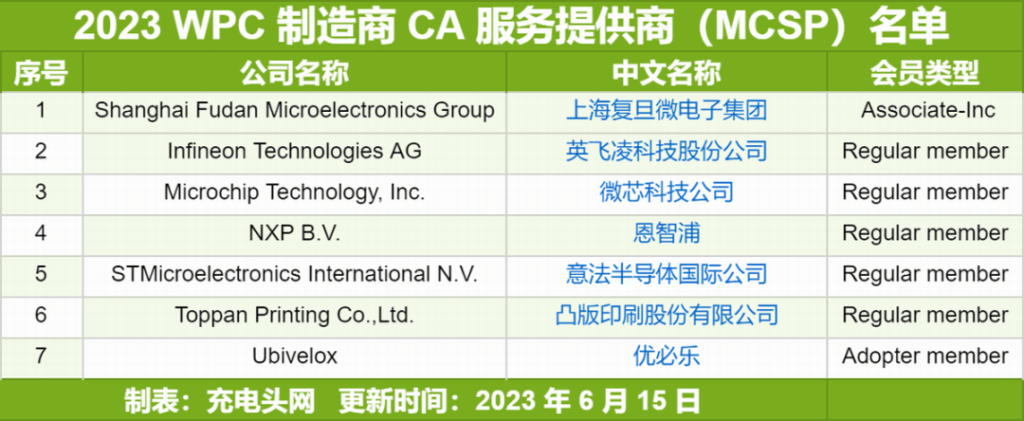
In the current MCSP list, Shanghai Fudan Micro Company’s membership level is Associate-Inc (Associate member), which is the only MCSP recognized by WPC in China; Most of the other membership levels are Regular member (full member), and the membership level of Korea Ubi Company is Adopter member (ordinary member).
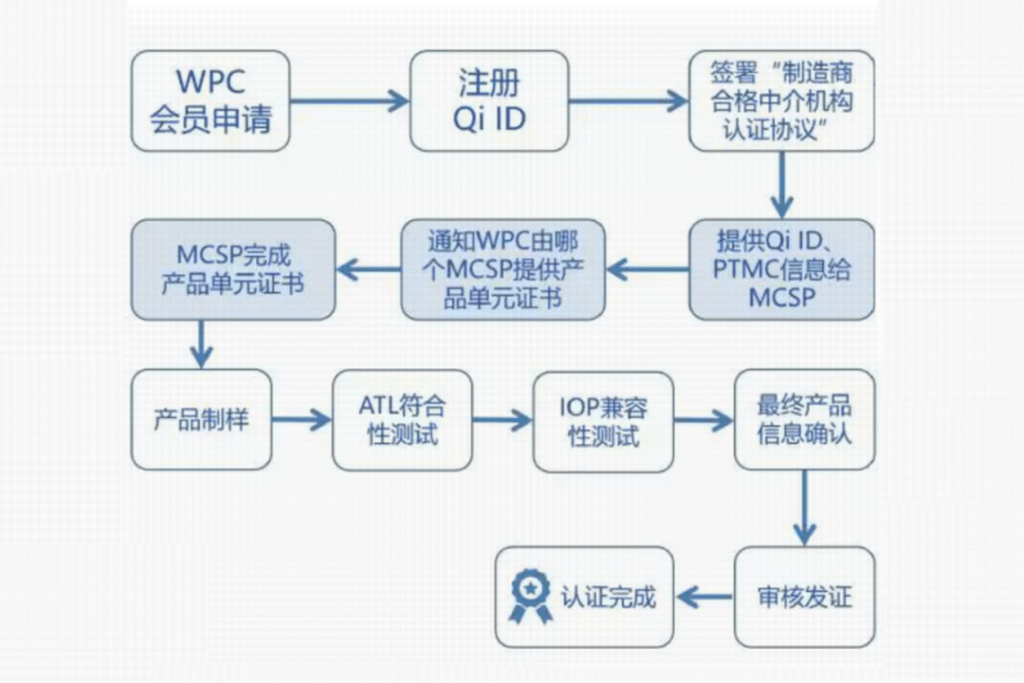
As shown in the figure, the complete WPC certification process consists of 12 processes. It provides Qi ID and PTMC information to MCSP, informs WPC which MCSP provides the product unit certificate, and MCSP completes the product unit certificate, which is a new certification process after Qi 1.3.3 version.
4.3 Qi-MPP certification
Understand MPP authentication mainly because of its new features compared to previous protocols. It is summarized as follows:
1. New 360kHz operating frequency (previously 110kHz-205kHz)
2, a new communication scheme, adding 55 kinds of data packets on the original foundation (Qi1.3)
3. Extend the authentication scheme
4, Open-air Q value test (foreign body detection before power transmission)
5, k value measurement (a new variable used to express the coupling coefficient)
6. Clocking (new mechanism of non-inductive power transmission suspension and recovery at the receiving end)
7. Role swap (Role swap, reverse charging)
4.4 WPC latest Board list
At present, Qi2 certification work is in full swing, as the WPC leading organization of the council is actively promoting at this time, charging head network according to the WPC official website announced the list of members, collate the relevant information information drawn into a table, take a look at:
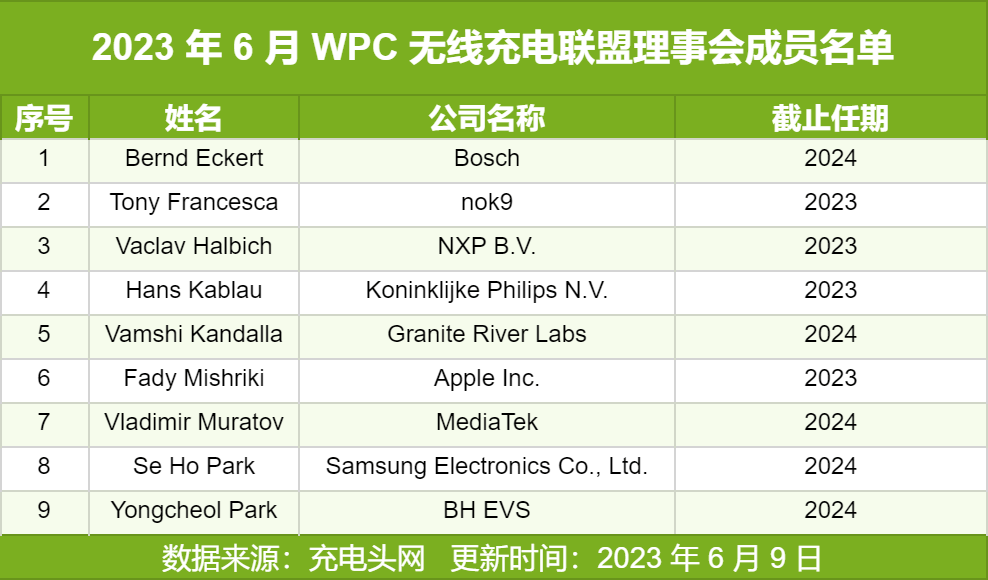
The WPC council members include Apple, Samsung, Mediatek, NXP, Philips, nok9, Bosch, GRL, BH EVS, a total of nine companies, covering electronic product terminals, certification testing companies, semiconductor companies, electronic product suppliers, electronic product terminals and other industry leaders, with full authority. Fady Mishriki from Apple Inc. also serves as the Board Chairman of the WPC Board.
5. Summary
The technical specifications of the products are the development track to ensure the unity and stable growth of the market, and play a vital role in the ecology of the industry. As the latest wireless fast charging standard launched by WPC, Qi2 has attracted the attention of many practitioners once it is released, and the formal certification process is expected to start in August 2023.
At present, there are still some technical difficulties in the authentication of Qi2. Firstly, in the authentication process, it is mainly reflected in the two aspects of huge data volume verification and new exception handling; Secondly, because MPP 360kHz is a new operating frequency, the coupling characteristics at this frequency have higher requirements for coils and resonant capacitors, and the decoding capability hardware and software need to be verified, which also brings certain difficulties to the certification work.
However, in any case, in the face of technological updates, there must always be a process of technological exploration and adaptation, we look forward to Qi2 protocol certification after the full start of the wireless fast charge terminal to bring more changes.
